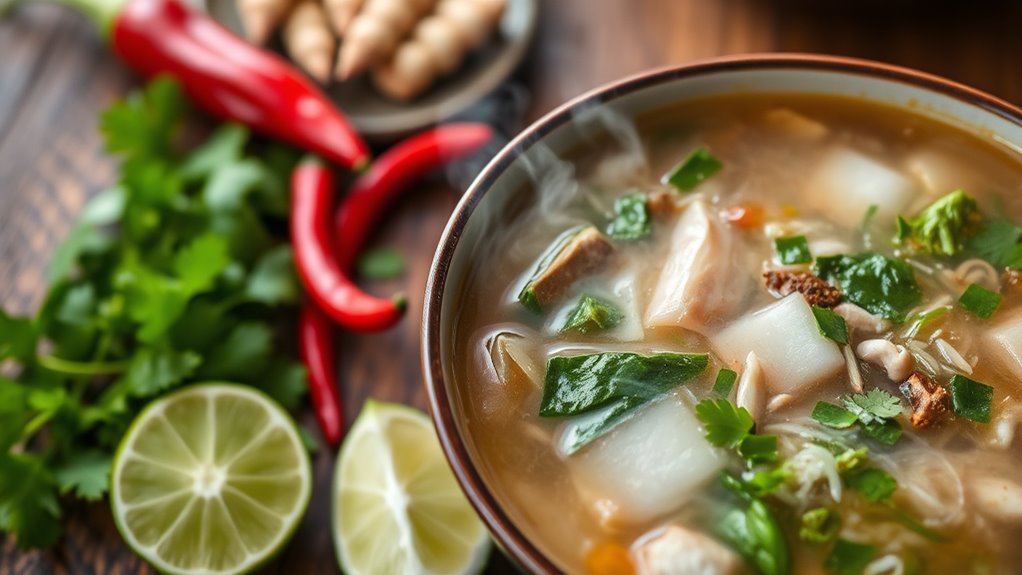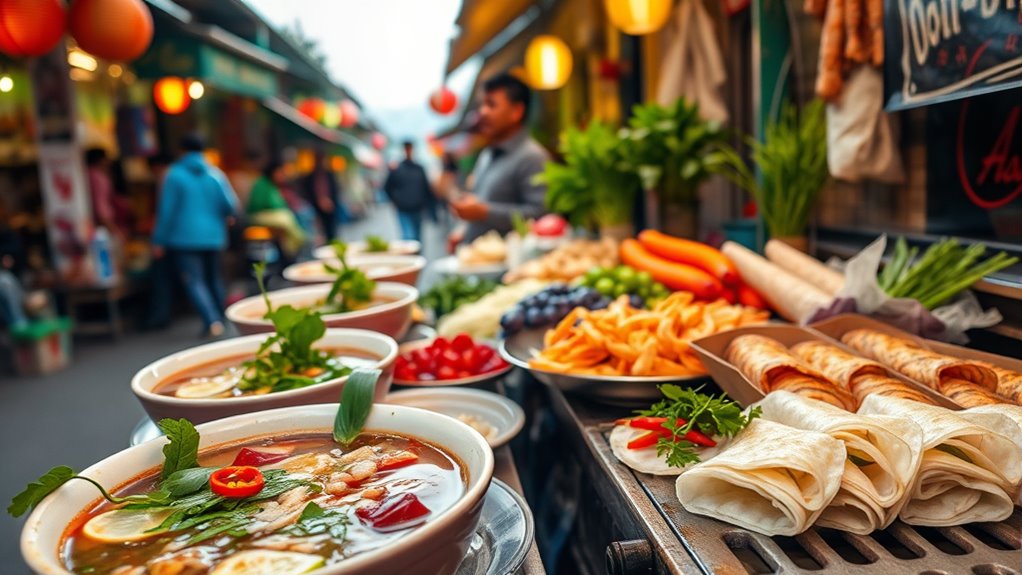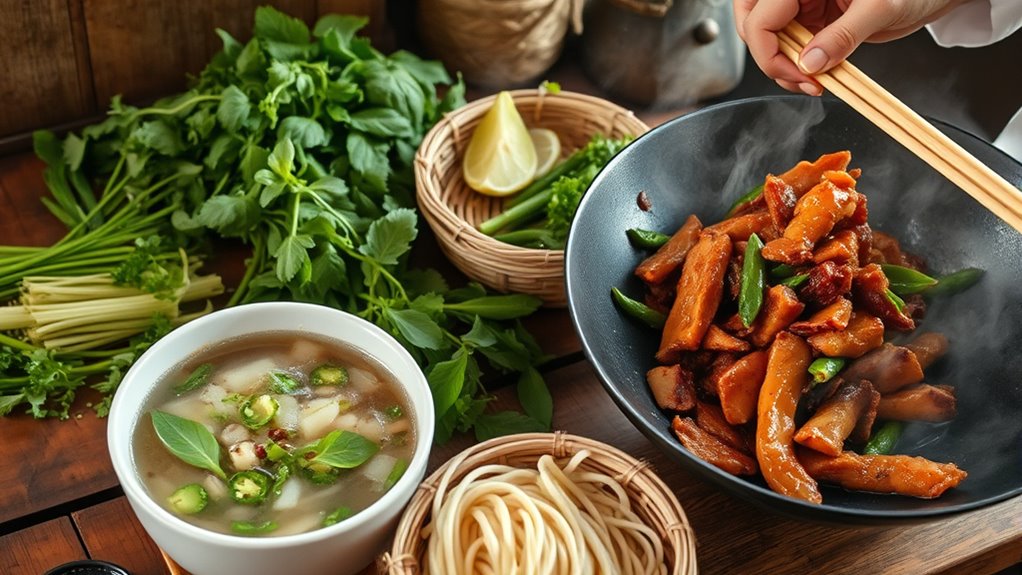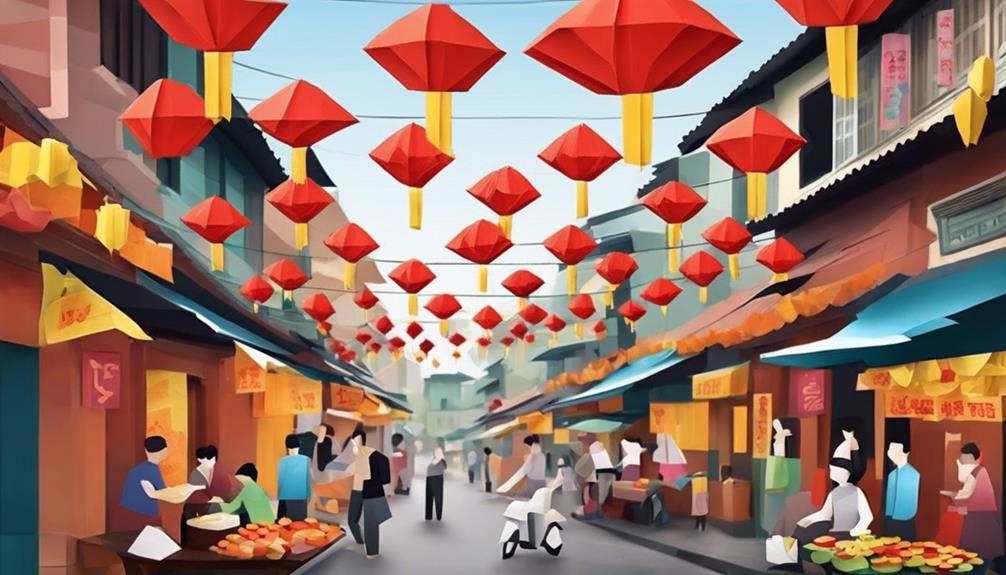Vietnamese cuisine highlights fresh, seasonal ingredients with simple techniques like grilling, steaming, and stir-frying. You’ll enjoy dishes like phở, bánh mì, and gỏi cuốn that blend herbs, vegetables, and balancing flavors such as sweet, salty, sour, spicy, and umami. Meals are shared communally with rice at the center, and dipping sauces add extra flavor. Explore regional differences from mild northern to bold central and sweet southern flavors—there’s much more to discover in Vietnam’s flavorful culinary world.
Key Takeaways
- Vietnamese cuisine emphasizes fresh, seasonal ingredients, minimal oil, and balancing five fundamental tastes through herbs, vegetables, and condiments.
- Iconic dishes like Phở, Bánh mì, and Gỏi cuốn showcase Vietnam’s vibrant, diverse, and flavorful food culture.
- Culinary styles vary regionally: Northern mild flavors, Central spicy and bold, Southern sweet and sour, reflecting local ingredients and traditions.
- Meals are centered around rice, with communal sharing, dipping sauces like nước chấm, and respectful dining customs.
- Key ingredients include herbs, seafood, pork, vegetables, and flavorings like fish sauce, tamarind, and chili, prepared through grilling, boiling, and stir-frying.
Core Principles and Characteristics of Vietnamese Cuisine

Vietnamese cuisine centers on fresh, seasonal ingredients, with minimal use of oil and straightforward cooking techniques that highlight herbs and vegetables. You’ll notice dishes balancing five fundamental tastes: sweet, salty, sour, spicy, and umami, creating harmonious flavors in every bite. Meals are often shared communally, with dishes placed at the center for everyone to enjoy together. Rice (*cơm trắng*) is the staple, served at nearly every meal, accompanied by flavorful condiments like *nước chấm*. Herbs such as cilantro, mint, and Thai basil play a vital role, adding freshness and aroma. Techniques like grilling, boiling, steaming, and stir-frying are common, emphasizing simplicity and purity of flavor. This approach reflects Vietnam’s emphasis on natural ingredients and balanced, vibrant tastes. Proper storage of herbs and ingredients can help maintain their freshness and flavor for optimal culinary results.
Iconic National and Street Food Delights
| Dish | Main Ingredients | Regional Popularity |
|---|---|---|
| Phở | Beef/chicken, herbs, rice noodles | Nationwide |
| Bánh mì | Baguette, pork, vegetables, chili | Urban centers |
| Gỏi cuốn | Shrimp, pork, herbs, rice vermicelli | North & South |
| These culinary delights showcase Vietnam’s vibrant, fresh, and diverse food culture.
Regional Culinary Diversity and Specialties

Have you noticed how Vietnam’s diverse regions each boast their own distinctive flavors and culinary traditions? From north to south, the cuisine varies greatly, reflecting local ingredients and history. In the north, you’ll find mild, subtle flavors like *bún thang* and sticky rice cakes (*bánh chưng*). Central Vietnam is famous for bold, spicy dishes such as *bún bò Huế*. The south offers sweeter, bolder tastes with dishes like caramelized fish (*cá kho tộ*) and sour soups (*cánh chua*). Highland cuisines highlight forest herbs and game meats, while urban areas thrive on street food, contrasted with rural meals centered on homegrown produce.
- Northern dishes: mild, subtle flavors
- Central specialties: spicy, bold flavors
- Southern favorites: sweet and diverse
- Highland cuisine: herbs and game
- Urban vs. rural: street food vs. traditional
Typical Meal Structure and Dining Customs

Meals in Vietnam are thoughtfully structured around rice as the central element, with each component arranged to foster communal sharing. You’ll typically have individual bowls of white rice, while main dishes like fish, meat, or tofu are placed in the center for everyone to serve themselves. Vegetables and light soups accompany these, adding freshness and balance. Dipping sauces like *nước chấm* are essential, enhancing flavors and encouraging interaction. It’s customary to serve elders first and invite others in order of age, reflecting respect and harmony. Sharing food, passing dishes, and offering bites to others are signs of care. Meals are more than nourishment—they’re social occasions that strengthen bonds, highlight family values, and celebrate Vietnam’s rich culinary traditions. Understanding the refrigeration cycle behind traditional cooking methods can deepen appreciation for how food is preserved and prepared in Vietnamese cuisine.
Key Ingredients and Cooking Techniques

Vietnamese cuisine relies on a vibrant palette of ingredients that emphasize freshness and natural flavors. You’ll find herbs like cilantro, mint, Thai basil, perilla, and Vietnamese coriander adding brightness to dishes. Protein sources include fish, seafood, pork, beef, poultry, and tofu, used sparingly to enhance flavor. Vegetables such as morning glory, water spinach, bamboo shoots, and bean sprouts are staples, providing texture and freshness. Flavor bases like fish sauce, shrimp paste, soy sauce, tamarind, lime, and chili create complex, balanced tastes. You’ll notice cooking methods like grilling, boiling, steaming, stir-frying, and stewing dominate, while deep-frying is less common. These techniques and ingredients come together to produce dishes that are light, aromatic, and full of nuanced flavors. Additionally, understanding sound design techniques can enhance the presentation of culinary content through engaging multimedia.
Frequently Asked Questions
How Do Vietnamese Meals Accommodate Dietary Restrictions and Preferences?
You can easily adapt Vietnamese meals to your dietary restrictions and preferences. Since meals emphasize fresh herbs, vegetables, and lean proteins, you can choose plant-based options or specify no meat or seafood. Many dishes are customizable with dipping sauces or condiments, allowing you to control salt or spice levels. Sharing dishes makes it simple to pick and choose, and you can request modifications like steamed or stir-fried vegetables to suit your needs.
What Are Traditional Vietnamese Desserts Beyond Chè?
You’ll find traditional Vietnamese desserts beyond chè that highlight fresh ingredients and delicate flavors. You might enjoy bánh flan, a caramel custard with a silky texture, or bánh chuối, a banana cake often steamed with coconut milk. Chè trái cây, a fruit cocktail with sweet syrup, is popular as a light, invigorating treat. These desserts emphasize natural sweetness, herbs, and textures, making them perfect for ending a meal or enjoying as a snack.
How Has French Colonial History Influenced Modern Vietnamese Cuisine?
French colonial history has profoundly shaped modern Vietnamese cuisine, transforming it into a culinary masterpiece that’s as diverse as it is delicious. You’ll notice French influences in dishes like bánh mì, with its crusty baguette and pâté, and coffee, often brewed strong and sweet. French cooking techniques and ingredients, such as butter and bread, blend seamlessly with traditional Vietnamese flavors, creating a unique fusion that’s both comforting and innovative.
Are There Specific Table Manners Unique to Vietnamese Dining?
You should remember that Vietnamese dining emphasizes communal sharing and respect. Always serve elders first and invite others to eat in order of age. Use chopsticks or a spoon to pick up food, and avoid sticking chopsticks upright in rice, as it resembles a funeral ritual. Tasting broth before adding condiments shows respect for the cook. Sharing dishes and passing plates politely foster harmony and show good manners during meals.
How Do Regional Ingredients Affect the Flavor Profiles of Dishes?
Regional ingredients completely transform the flavor profiles of your dishes, making each region’s cuisine a unique explosion of taste. In the north, you’ll find mild, subtle flavors from herbs and light broths. Central Vietnam’s bold, fiery spices hit your palate like a flavor fireworks show. Meanwhile, the south’s sweet and diverse ingredients create a vibrant, tropical symphony. These local ingredients turn simple dishes into unforgettable culinary adventures, each region’s flavors dancing on your taste buds.
Conclusion
Exploring Vietnamese cuisine is like opening a vibrant, flavorful tapestry that invites your senses to dance. Its rich blend of fresh ingredients, bold flavors, and cherished traditions creates a culinary journey as comforting as a warm embrace. By tasting its iconic dishes and embracing its diverse regional styles, you’ll discover a culture as lively and inviting as a bustling market. Immerse yourself and let Vietnam’s food enchant you, leaving your heart and palate forever changed.










